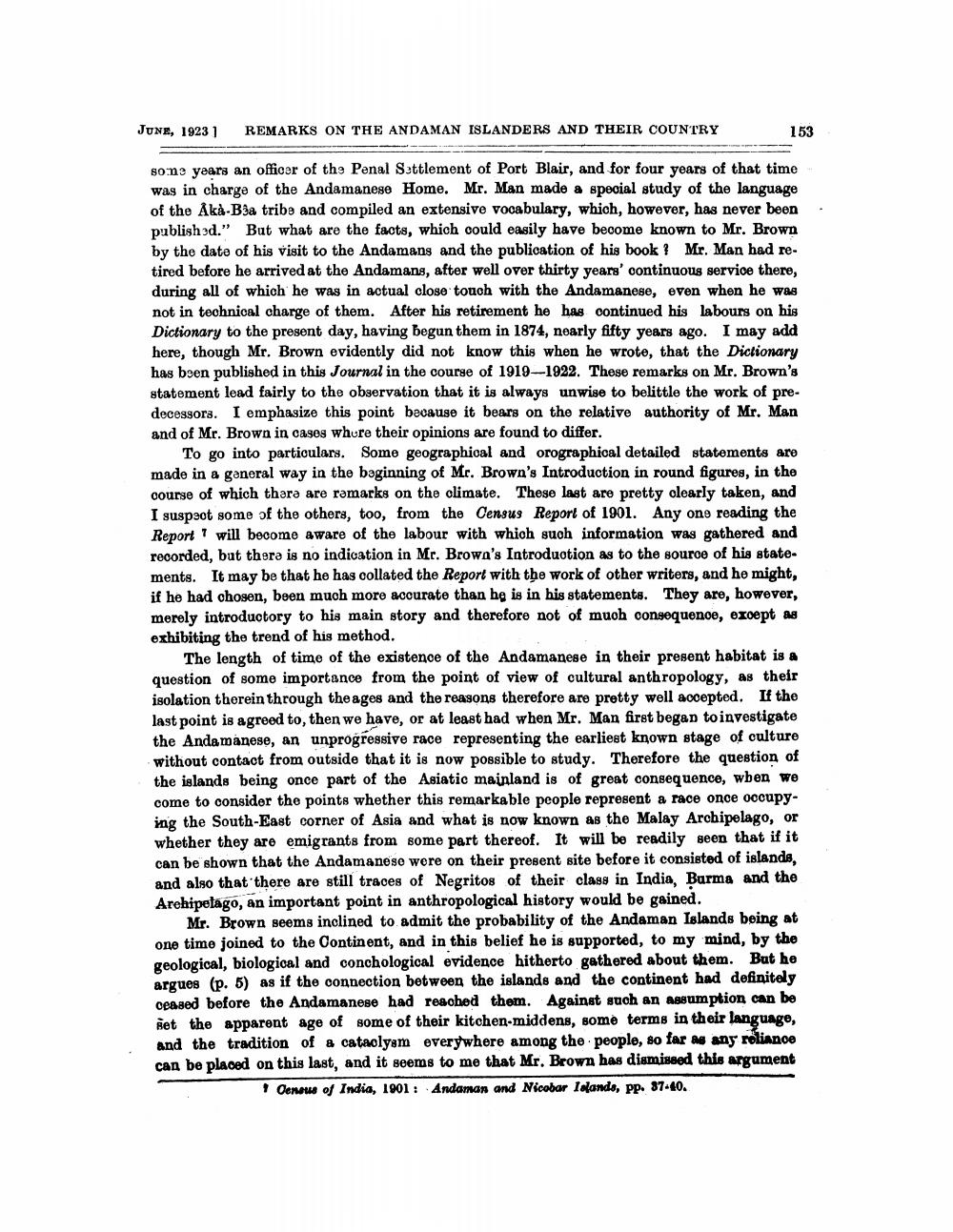________________
JUNE, 1923)
REMARKS ON THE ANDAMAN ISLANDERS AND THEIR COUNTRY
153
some years an officer of the Penal Settlement of Port Blair, and for four years of that time was in charge of the Andamanese Home. Mr. Man made a special study of the language of the Aka-Bia tribe and compiled an extensive vocabulary, which, however, has never been published." But what are the facts, which could easily have become known to Mr. Brown by the date of his visit to the Andamans and the publication of his book ? Mr. Man had retired before he arrived at the Andamans, after well over thirty years' continuous service there, during all of which he was in actual close touch with the Andamanese, even when he was not in technical charge of them. After his retirement he has continued his labours on his Dictionary to the present day, having begun them in 1874, nearly fifty years ago. I may add here, though Mr. Brown evidently did not know this when he wrote, that the Dictionary has been published in this Journal in the course of 1919-1922. These remarks on Mr. Brown's statement lead fairly to the observation that it is always unwise to belittle the work of predecessors. I emphasize this point because it bears on the relative authority of Mr. Man and of Mr. Brown in cases whure their opinions are found to differ.
To go into particulars. Some geographical and orographical detailed statements are made in a general way in the baginning of Mr. Brown's Introduction in round figures, in the course of which thara are ramarks on the climate. These last are pretty clearly taken, and I suspect some of the others, too, from the Census Report of 1901. Any one reading the Report' will become aware of the labour with which such information was gathered and recorded, but there is no indication in Mr. Brown's Introduotion as to the source of his state. ments. It may be that he has collated the Report with the work of other writers, and he might, if he had chosen, been much more accurate than he is in his statements. They are, however, merely introductory to his main story and therefore not of much consequenoe, except as exhibiting the trend of his method.
The length of time of the existence of the Andamanese in their present habitat is a question of some importance from the point of view of cultural anthropology, as their isolation therein through the ages and the reasons therefore are pretty well accepted. If the last point is agreed to, then we have, or at least had when Mr. Man first began to investigate the Andamanese, an unprogressive race representing the earliest known stage of culture without contact from outside that it is now possible to study. Therefore the question of the islands being once part of the Asiatic mainland is of great consequence, wben we come to consider the points whether this remarkable people represent a race once occupying the South-East corner of Asia and what is now known as the Malay Archipelago, or whether they are emigrants from some part thereof. It will be readily seen that if it can be shown that the Andamanoso were on their present site before it consisted of islands, and also that there are still traces of Negritos of their class in India, Burma and the Arehipelago, an important point in anthropological history would be gained.
Mr. Brown seems inclined to admit the probability of the Andaman Islands being at one time joined to the Continent, and in this belief he is supported, to my mind, by the geological, biological and conchological evidence hitherto gathered about them. But he argues (p. 5) as if the connection between the islands and the continent had definitely orased before the Andamanese had reached them. Against such an assumption can be Ret the apparent age of some of their kitchen-middens, some terms in their language, and the tradition of a cataolyam everywhere among the people, so far as any reliance can be placed on this last, and it seems to me that Mr. Brown has dismissed this argument
Oenou of India, 1901: Andaman and Nicobar Islands, Pp. 37-40.




